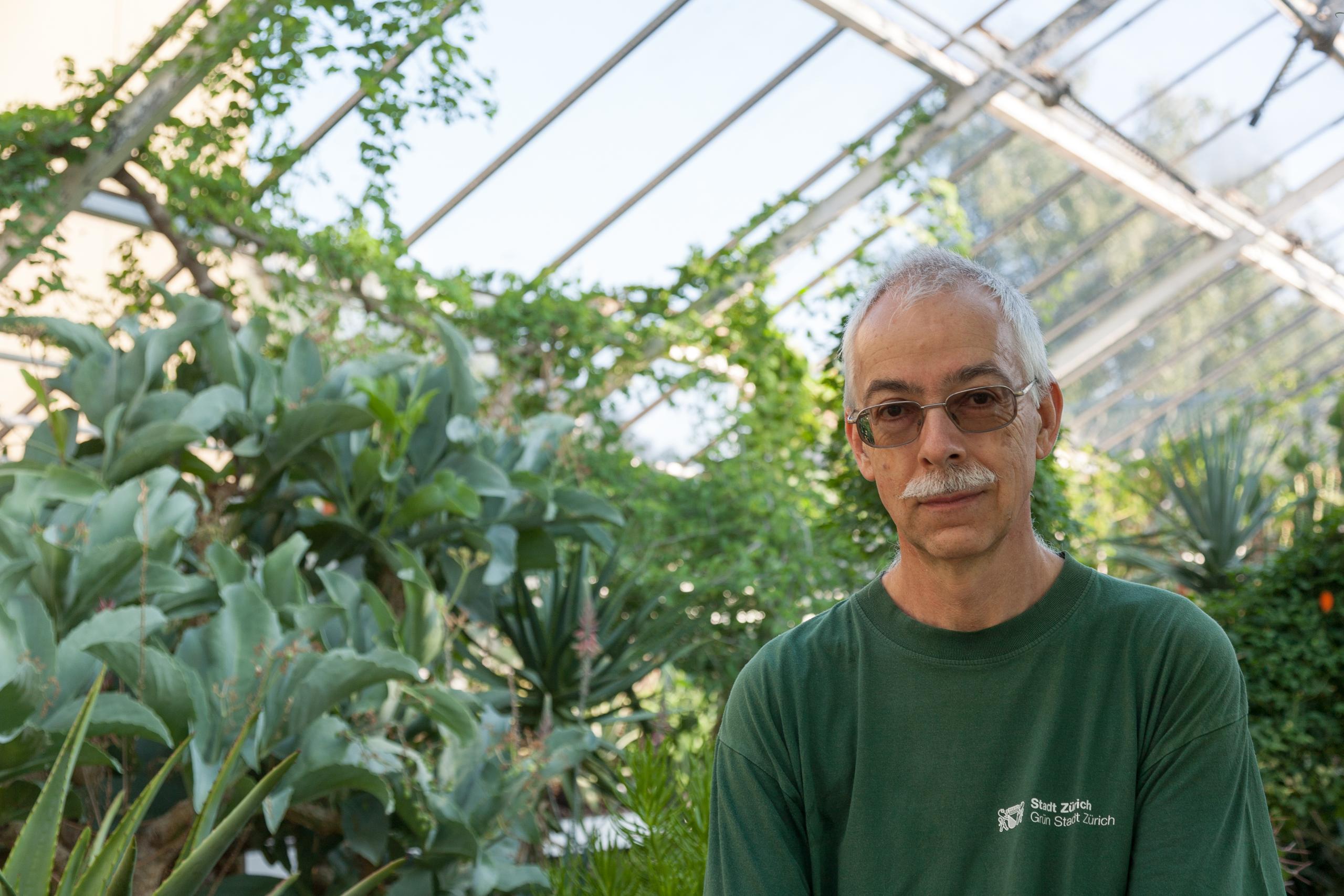Succulents – spiky, flowery, fascinating

Zurich hosts one of the world’s leading collections of its succulent plants, containing 5-6,000 species or up to a half of all known succulents. But what is this exotic and scientifically important collection doing in the city of bankers and insurance?
Urs Eggli, the scientist at the Zurich Succulent Plants CollectionExternal link, or “Sukki” as it is known locally, is standing in the Africa House – one of seven greenhouses on the site open to the public. He is pointing to what appears to be a large cactus. Except that it isn’t. It’s actually a succulent from the Spurge family.
“One has to look quite carefully to distinguish it from a true cactus,” Eggli told swissinfo.ch. “If you look at the spines for instance you will see that there are always two spines at the same place. If you compare with a cactus there will be several, perhaps 20 or so spines, in the same place.”
So we come straight to the thorny issue: every cactus is a succulent – a water-storing plant – but not every succulent is a cactus. Succulents are found in many plant families, including agaves and aloes. The difference between cacti and similar-looking succulents forms part of the collection’s current exhibition: Everything cacti?External link

More
Succulents and cacti in all their glory
The succulent collection is located on the Mythenquai – the Zurich lakeside area also known for the imposing buildings of certain consulting and insurance giants.
“Historical chance”
Its founding was “by historical chance”, Eggli said. In the 1920s, retiring professional cactus nursery owner Jakob Gasser offered to sell his private cacti collection – containing 1,516 plants – to the city of Zurich. It was eventually bought by a private individual and donated to the city.
In 1931 the collection was opened on the site of the former municipal gardens, with just one greenhouse. Since its inception, the Succulent Collection has been part of the municipal Office of Parks and Open Spaces, now known under the name of Grün Stadt Zürich. It was an immediate public success.
Now the site contains over 25,000 plants across almost 5,000 square metres, making it one of the world’s leading collections of its kind. Other displays worldwide are spread over larger areas, Eggli said.
“The thing which is different in Zurich is that we try to have a representative selection of succulents from all families and geographical regions. So we are not devoted primarily to African succulents or to the Arizona cactus,” he explained.
“Between 5-6,000 plant species being cultivated here, which are between a third and half of all known succulent plants, something which is quite exceptional.”
A magnet
Botanists from all over the world visit or ask for expertise. A focal point is the collection’s herbarium, an extensive plant archive, which was founded in close cooperation with the International Organisation for Succulent Plant Study (IOS) in the 1950s. The herbarium, as well as the living collection of plants, now stands under the patronage of the Swiss Commission for Unesco.External link
In addition, up to 45,000 members of the public visit the collection every year. Particularly appreciated is the flowering season.
One of the big magnets is the Queen of the Night, or Selenicereus grandiflorus. Quite ugly for most of the year, it is transformed into a thing of beauty when its flowers open up, for a short time overnight, emitting the scent of vanilla and chocolate.
CITES
Creating such a collection from scratch would be an impossible feat today. Apart from not being able to match the sheer diversity and size of the plants – mostly only seedlings would be available today – there are strict rules on what can be brought into Switzerland under CITES,External link the Convention on International Trade in Endangered Species of Wild Fauna and Flora.
The trade agreement, aimed at achieving sustainable use of the world’s flora and fauna, has been signed by 180 nations worldwide, including Switzerland.
Many succulent plants are covered by the treaty. More recently the Rio biodiversity convention as well as the Nagoya protocolExternal link, regulating access and benefit sharing for natural resources, have come into force, adding even more restrictions to the complexities of international plant exchange.
No expeditions
So gone are the days when people simply went on expeditions and took what they wanted, Eggli said.
“Most of the material in botanical collections is being exchanged between likeminded institutions anyway. Our collection is exchanging seed lists with about 200 botanical institutions from all over the world,” Eggli explained. “There is virtually no need at all to go out into the field to gather plants.”
CITES also affects hobby collectors as well. Swiss Cactus SocietyExternal link president Adrian Lüthy says there are both positive and negative aspects: on the one hand, you can see more plants in the field, but on the other, it’s sometimes not easy to get plants from abroad due to the paperwork.
It is practically impossible to legally export from Mexico, at least for private individuals, he added.
Challenges, fascination
Running a large botanical collection, such as in Zurich, presents some challenges. Most of the succulents are relatively easy to cultivate – even so far away from their native, drier climates, Eggli said. But a lot of care is needed due to the sheer number of plants in the collection.

Another issue is that the collection’s infrastructure is outdated. “If it was completely newly built we would have automated greenhouses,” Eggli said. “In our case much of the infrastructure is still manually operated and controlled, so apart from watering, a lot of time is also needed for controlling all the equipment, to keep it running – and this time should better be devoted to the best possible care for the plants.”
During the period 2005-2011, plans were mooted to expand or even completely rebuild the site, but they have stalled for financial reasons, he said.
So what is the fascination of succulents and cacti, which, as Eggli observed, are back in fashion, if you look at florists and people’s homes?
The systematic botanist, who has been at the collection for almost 30 years, appreciates the diversity of succulents, which have evolved in parallel in so many plant families, under different conditions.
“It’s also perhaps the mixture of being horrible, prickly and ‘don’t touch me’ and, at the same time, having a certain regularity, attractiveness,” he continued. “So it’s these opposing elements mixed together.”
Swiss Cactus Society
The Swiss Cactus Society, which represents local groups of cactus enthusiasts across the country, has 700 members.
Its president, Adrian Lüthy, has also observed that succulents and cacti seem to be back in fashion. There are certainly more cactus fans in the country than members of the society, he says.
Members range from those with a few cacti at home to those with extensive private collections. Lüthy himself has 20 metres squared of greenhouses in which he breeds cacti hybrids. These hybrids and the beautiful flowers produced by cacti form part of their fascination, he says.
Cacti facts
There are almost 1,900 species of cacti. “All are native to the New World, with one exception: the spaghetti cactus, which also occurs in Africa, Madagascar and Sri Lanka,” explained Urs Eggli.
Cacti and succulents can have attractive flowers and even produce fruit although often, such as in the case of the Cyphostemma, a member of the grape family, it is unpleasant. The juice interior of cactus stems can bitter and astringent, Eggli says.
It is hard to say why cacti have spines. One theory is that they deter hungry animals. But they might also offer a way to collect moisture by helping to condense early morning dew, or even offer shade to the plant.
The current exhibition “Everything cacti?”,External link that runs until January 10, 2016, explores the differences between cacti and succulents that look like cacti. This is the first time that the evolution of this plant diversity as a result of adverse living conditions has been covered in this way an exhibition in Switzerland. At the entrance stands a ‘watering can cactus’ where the volume of the 20 watering cans is equivalent to how much water a columnar cactus (Pachycereus pringlei) from the collection can hold – 200 litres. A huge family tree shows the relations between succulents.

In compliance with the JTI standards
More: SWI swissinfo.ch certified by the Journalism Trust Initiative











You can find an overview of ongoing debates with our journalists here . Please join us!
If you want to start a conversation about a topic raised in this article or want to report factual errors, email us at english@swissinfo.ch.